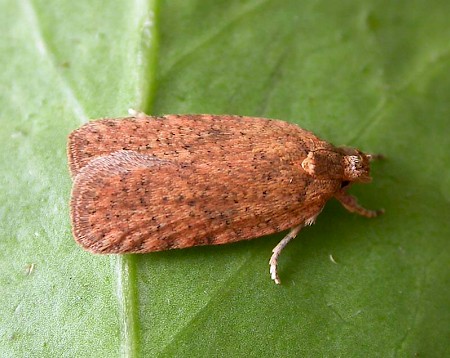32.013 BF708
Agonopterix carduella
(Hübner, [1817])
Wingspan 14-17 mm.
A local species in Britain, preferring dry open sites, such as grassland on limestone.
Adults occur July to May, hibernating over winter. Examination of genitalia is advised, as it can be confused with small specimens of A. subpropinquella.
Larvae feed May to July on thistles (Cirsium spp.) common knapweed (Centaurea nigra) and burdock (Arctium spp.). Late instar larvae are distinctive, but early instars, less than 10 mm, can be confused with A. propinquella.
- Larva: (description Ian F. Smith):
Foodplants: May to July on Cirsium vulgare, C. arvense, C. heterophyllum, Centaurea nigra and Arctiumspp.. At first, in a leaf mine which may be whitish and include the midrib. Later, below a leaf and, if onCentaurea, in a browned leaf folded downwards.
Early instar
Length: Less than about 10 mm.
Head: Black
Prothorax (T1): Anterior border whitish. Prothoracic shield black, divided by a barely perceptible fine yellowish white medial line.
Thoracic legs: Concolorous with venter of body.
Body: Translucent yellowish white or yellowish. Viscera may show greenish dorsally, and frass in posterior segments may show as a dark shadow.
Spiracles: Small, brownish.
Pinacula: Concolorous with body. Setal spot slightly darker.
Setae: Translucent whitish.
Anal plate: Concolorous with body. Irregular pattern of more transparent marks showing darker if frass in anal segment.
Prolegs: Concolorous with or paler than venter. Crochets very pale brown.
Similar species: A. propinquella often has a translucent brownish patch subdorsally on the head and usually occurs in July - August when A. carduella has usually developed its late instar black anal plate. Specimens under 10 mm should be reared to see if black anal plate is acquired.
The black pinacula distinguish late instar A. subpropinquella from A. propinquella and early instars ofA. carduella. The writer does not know if early instar A. subpropinquella have black pinacula. If they do not, they could be confused with these two species. It is advisable to rear small larvae to over 10 mm, or to imago.
Late instar
Length: 13 mm described.
Head: Black
Prothorax (T1): Anterior border whitish. Prothoracic shield black, divided by a fine yellowish white medial line.
Thoracic legs: Light brown. Coxa concolorous with venter.
Body: Dull brownish green or greyish green. Translucent dorsal line may show darker green contractile dorsal vessel. Pre-pupation body reddish except intersegmentally, and segments T2 and T3 less red.
Spiracles: Small, brownish.
Pinacula: Black.
Setae: Translucent brown.
Anal plate: Densely black.
Prolegs: Concolorous with venter. Crochets pale brown.

 UKMoths
UKMoths 







